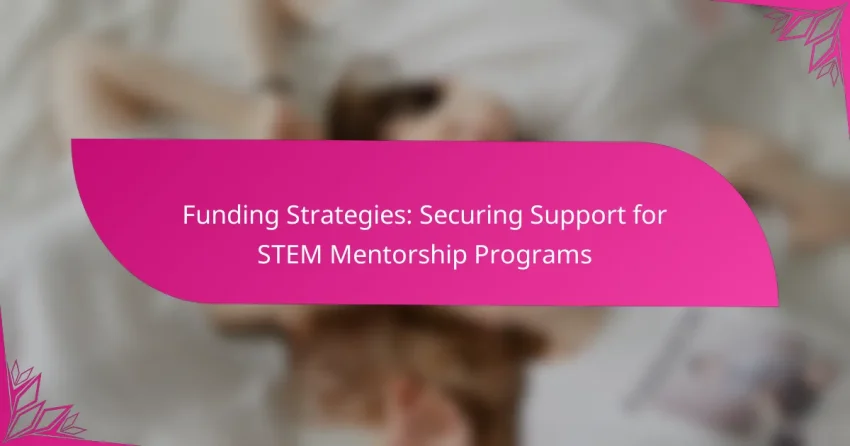Securing funding for STEM mentorship programs is essential for their sustainability and growth. Effective strategies include leveraging grants, corporate sponsorships, community fundraising, and crowdfunding platforms, each offering distinct advantages. By evaluating potential funding sources based on alignment with program goals and accountability requirements, organizations can ensure they effectively support their initiatives while advancing their mission.

What are effective funding strategies for STEM mentorship programs in the US?
Effective funding strategies for STEM mentorship programs in the US include securing grants, corporate sponsorships, community fundraising, and utilizing crowdfunding platforms. Each method offers unique advantages and considerations that can help organizations sustain and grow their mentorship initiatives.
Grant applications from the National Science Foundation
The National Science Foundation (NSF) provides various grant opportunities specifically aimed at enhancing STEM education and mentorship. Programs like the Innovative Technology Experiences for Students and Teachers (ITEST) grant can be particularly beneficial.
When applying for NSF grants, ensure your proposal clearly outlines the program’s goals, expected outcomes, and how it aligns with NSF priorities. Pay attention to submission deadlines and eligibility requirements, as these can vary significantly.
Corporate sponsorships from tech companies
Corporate sponsorships can provide substantial financial support for STEM mentorship programs. Many tech companies are eager to invest in initiatives that promote STEM education, as it aligns with their business interests and corporate social responsibility goals.
To attract corporate sponsors, develop a compelling sponsorship proposal that highlights the benefits to the company, such as brand visibility and community engagement. Consider reaching out to local tech firms or larger corporations with established philanthropic programs.
Community fundraising events
Community fundraising events are an effective way to engage local supporters and raise funds for STEM mentorship programs. Events can range from workshops and seminars to larger gatherings like science fairs or charity runs.
When planning an event, focus on creating a fun and educational experience that showcases the value of your program. Utilize social media and local partnerships to promote the event and maximize attendance, which can lead to greater fundraising success.
Crowdfunding platforms like GoFundMe
Crowdfunding platforms such as GoFundMe can be a quick way to raise funds for STEM mentorship initiatives. These platforms allow you to reach a broad audience and share your program’s mission and needs effectively.
To succeed in crowdfunding, create a compelling campaign page with a clear narrative, visuals, and specific funding goals. Promote your campaign through social media and email to engage friends, family, and community members who may be willing to contribute.
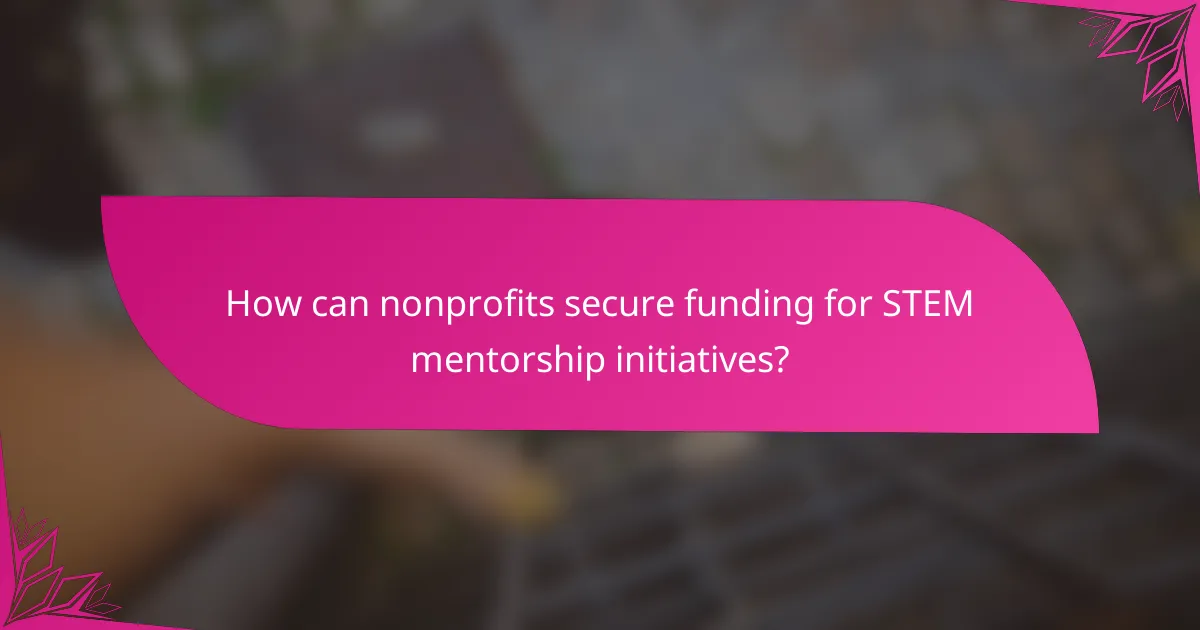
How can nonprofits secure funding for STEM mentorship initiatives?
Nonprofits can secure funding for STEM mentorship initiatives through strategic partnerships, grants, and alumni engagement. These approaches help organizations tap into various funding sources, ensuring sustainability and growth for their programs.
Partnerships with local educational institutions
Collaborating with local educational institutions can provide nonprofits with access to resources, expertise, and potential funding. Schools and universities often have budgets allocated for community outreach and educational programs, which can be leveraged to support STEM mentorship initiatives.
Establishing formal partnerships can include co-hosting events, sharing facilities, or developing joint programs. These collaborations not only enhance program visibility but also foster a sense of community involvement, increasing the likelihood of securing funding.
Utilizing federal and state education grants
Federal and state education grants are vital funding sources for nonprofits focused on STEM mentorship. Organizations should research available grants from agencies such as the National Science Foundation or local education departments, which often prioritize STEM initiatives.
Applying for these grants typically requires a clear project proposal, demonstrating how the mentorship program aligns with educational goals. Nonprofits should ensure they meet eligibility criteria and deadlines to maximize their chances of receiving funding.
Engaging alumni networks for contributions
Alumni networks can be a powerful resource for funding STEM mentorship programs. Engaging former students who have benefited from similar initiatives can lead to financial contributions and support through networking opportunities.
Nonprofits should create targeted outreach campaigns to connect with alumni, highlighting the impact of their contributions on current students. Offering various giving options, such as one-time donations or recurring contributions, can encourage alumni to support the cause actively.
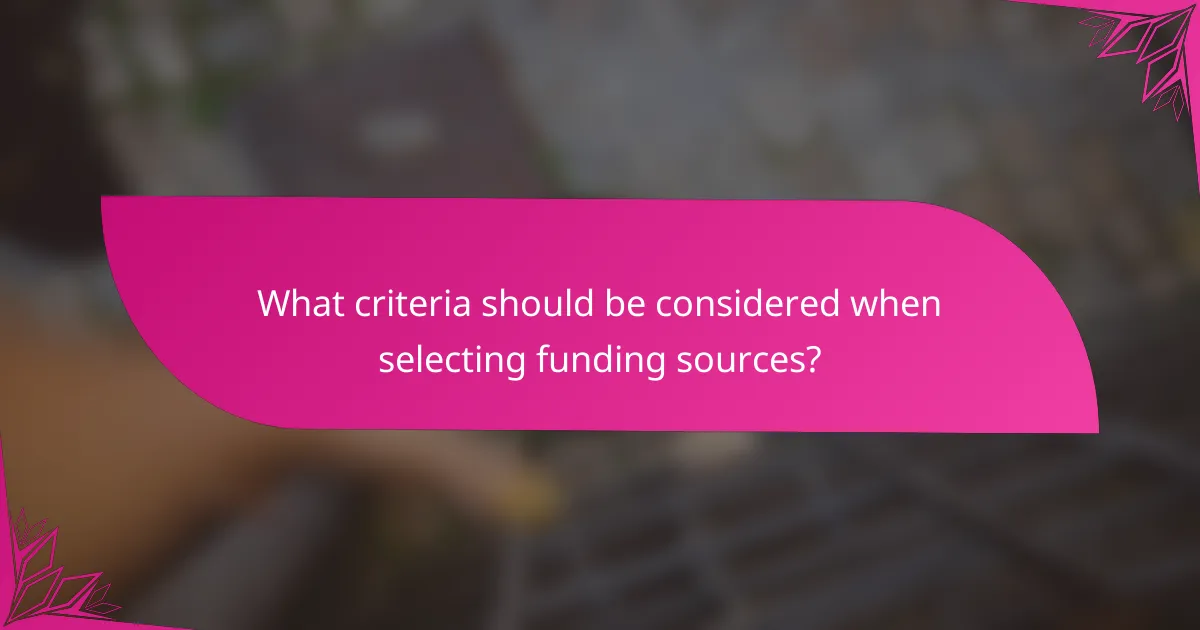
What criteria should be considered when selecting funding sources?
When selecting funding sources for STEM mentorship programs, it is crucial to evaluate criteria such as alignment with program goals, the funding amount and duration, and reporting and accountability requirements. These factors will help ensure that the funding not only supports the program effectively but also aligns with its mission and objectives.
Alignment with program goals
Choosing funding sources that align with your program goals is essential for long-term success. Funders often have specific missions and values, so it’s important to identify those that share a commitment to STEM education and mentorship. For instance, a foundation focused on promoting diversity in STEM may be a perfect match for a program aimed at underrepresented groups.
To assess alignment, review the funder’s past projects and initiatives. This can provide insight into their priorities and help you tailor your proposal to emphasize shared objectives. Engaging with potential funders early can also clarify how your program fits within their strategic framework.
Funding amount and duration
The funding amount and duration are critical factors that can significantly impact your program’s sustainability. Consider whether the funding will cover the entire program or just a portion, and whether it is a one-time grant or a multi-year commitment. For example, a grant of $50,000 for a single year may not be sufficient for a comprehensive mentorship initiative.
It’s advisable to seek a balance between adequate funding and the duration of support. Longer-term funding can provide stability, while smaller, short-term grants may require frequent reapplications, which can divert resources from program delivery. Aim for funding that aligns with your program’s timeline and financial needs.
Reporting and accountability requirements
Understanding the reporting and accountability requirements of potential funders is vital to ensure compliance and maintain a good relationship. Different funders may have varying expectations regarding progress reports, financial statements, and outcome evaluations. Some may require quarterly updates, while others might only need annual reports.
Before committing to a funding source, clarify these requirements and assess your program’s capacity to meet them. Overly burdensome reporting can strain resources and detract from program activities. Consider creating a checklist of reporting obligations to help manage expectations and ensure timely submissions.
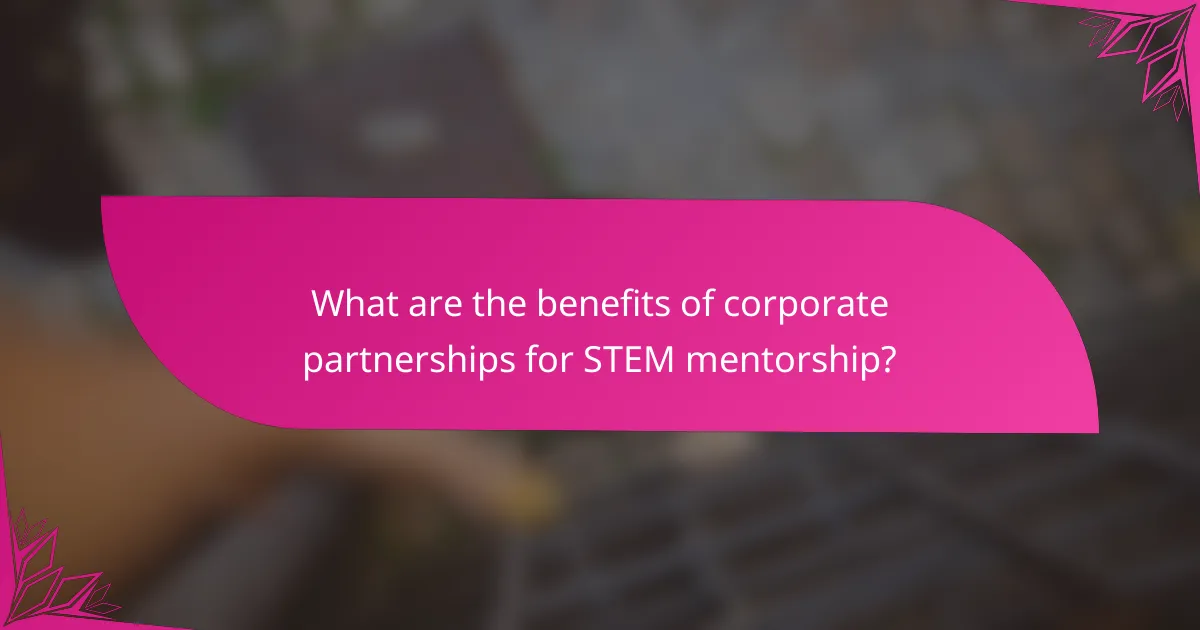
What are the benefits of corporate partnerships for STEM mentorship?
Corporate partnerships offer significant advantages for STEM mentorship programs, including enhanced resources, increased visibility, and opportunities for employee involvement. These collaborations can lead to more effective mentorship experiences and greater impact on students’ educational journeys.
Access to resources and expertise
Corporate partners can provide valuable resources such as funding, technology, and materials that are essential for effective STEM mentorship. This access allows programs to enhance their curriculum and offer hands-on experiences that may not be possible with limited budgets.
Additionally, businesses often bring industry expertise that can enrich mentorship programs. Professionals can share real-world insights and skills, helping students understand the practical applications of their studies.
Increased visibility and credibility
Partnering with reputable corporations can significantly boost the visibility of STEM mentorship programs. This association can attract more participants, sponsors, and media attention, which can lead to further opportunities for growth and funding.
Moreover, the credibility that comes from corporate involvement can reassure stakeholders, including parents and educational institutions, about the quality and relevance of the mentorship being offered.
Opportunities for employee engagement
Corporate partnerships often facilitate employee engagement through volunteer opportunities in mentorship roles. Employees can serve as mentors, providing students with guidance and support while enhancing their own skills in leadership and communication.
Furthermore, these partnerships can foster a sense of community within the company, as employees participate in meaningful initiatives that contribute to social responsibility and workforce development in STEM fields.
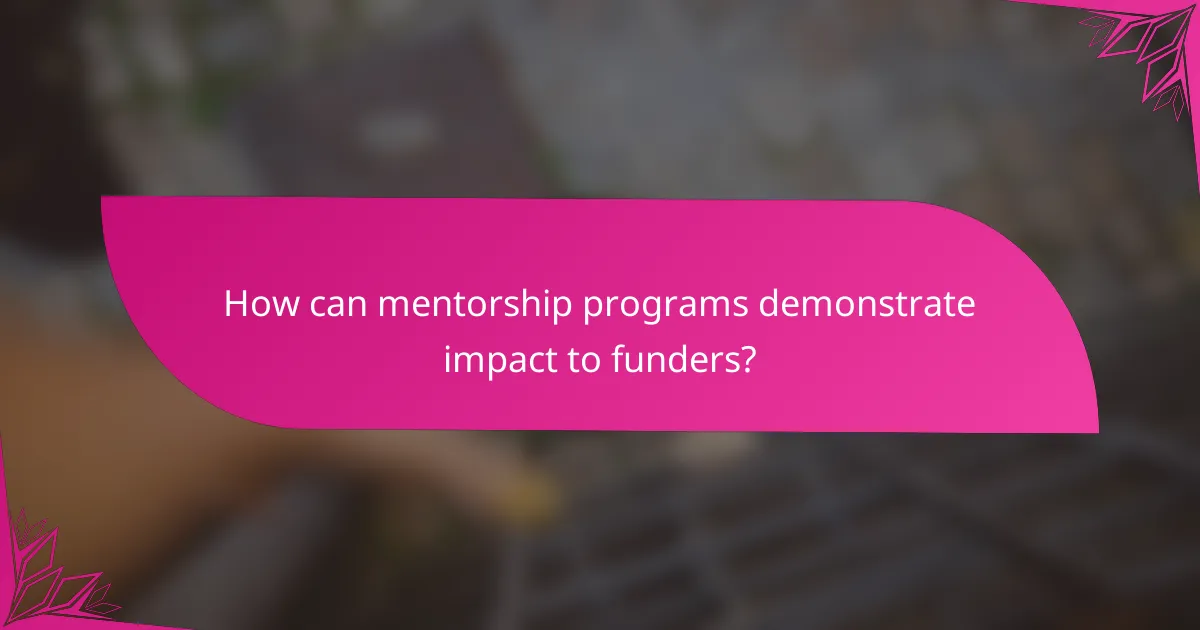
How can mentorship programs demonstrate impact to funders?
Mentorship programs can demonstrate their impact to funders by providing clear evidence of participant outcomes, sharing compelling success stories, and maintaining regular reporting on program activities. These strategies help build trust and show the tangible benefits of the program, making it easier to secure ongoing support.
Collecting data on participant outcomes
Collecting data on participant outcomes is crucial for showcasing the effectiveness of mentorship programs. This can include metrics such as academic performance, career advancement, and skill development. Programs should aim to gather both quantitative data, like test scores or job placements, and qualitative feedback through surveys or interviews.
Consider implementing a tracking system to monitor participants over time. This could involve follow-up surveys at regular intervals, such as six months or one year after program completion, to assess long-term impacts. Establishing benchmarks for success can also help in evaluating program effectiveness.
Sharing success stories and testimonials
Success stories and testimonials provide powerful narratives that can resonate with potential funders. Highlighting individual experiences can illustrate the real-world impact of mentorship, making the program relatable and inspiring. Use quotes from participants or mentors to add authenticity to these stories.
Consider creating a dedicated section on your website or in funding proposals that features these narratives. Visual elements, such as photos or videos, can enhance engagement and help funders connect emotionally with the program’s mission and outcomes.
Regular reporting on program activities
Regular reporting on program activities keeps funders informed and engaged. This can include updates on program milestones, participant engagement, and any challenges faced. Reports should be concise and focused, ideally provided quarterly or biannually, to maintain transparency and accountability.
Incorporate both qualitative and quantitative data in these reports. For example, include statistics on participant attendance and engagement alongside narratives about specific challenges and successes. This balanced approach can help funders understand the program’s ongoing evolution and its impact on participants.

What role do local governments play in funding STEM initiatives?
Local governments play a crucial role in funding STEM initiatives by providing financial support through various programs and resources. This funding can help develop mentorship programs that enhance educational opportunities in science, technology, engineering, and mathematics.
Providing grants and subsidies
Local governments often provide grants and subsidies specifically aimed at supporting STEM initiatives. These financial aids can come from state budgets or federal allocations, and they are typically designed to encourage educational institutions and non-profits to develop mentorship programs.
When applying for grants, organizations should focus on clearly outlining their objectives, expected outcomes, and how the funding will directly benefit the local community. It’s essential to research available grants, as they can vary widely in terms of eligibility, funding amounts, and application processes.
For example, a local government might offer grants ranging from a few thousand to tens of thousands of dollars, depending on the size and scope of the proposed STEM mentorship program. Organizations should also be aware of deadlines and reporting requirements to ensure compliance and maintain eligibility for future funding.
